09 Apr 2025
SAGEflex project to address lack of rigorous AI safeguarding for power system applications
As part of ARIA Safeguarded AI programme, SAGEflex aims to give power system operators confidence in adopting multi-agent reinforcement learning as an AI framework for flexibility in the power grid

Over the next decade, the transition to a net-zero power grid will involve millions of additional grid-edge devices in Great Britain, including electric vehicles, heat pumps, and home/community batteries. Studies have shown that flexibility equivalent to multiple large power plants can be obtained from grid-edge devices with only small adjustments in usage. The major challenge is that computational complexity and communication requirements make traditional centralised dispatch infeasible for grid-edge devices. This has motivated research into multi-agent reinforcement learning (MARL) which provides an AI-based framework for scalable and adaptive coordination. However, despite successes in other domains, and significant work by the power systems research community, the lack of safety guarantees has prevented industrial adoption of MARL by system operators and flexibility aggregators.
To address this issue, SAGEflex, a new project as part of the ARIA Safeguarded AI programme* will develop AI-based coordination of grid-edge flexibility at scale through MARL. A team of Engineering researchers at the University of Oxford aims to address this by developing rigorous safety specifications, a test problem curriculum, and a software platform supporting design, benchmarking and scaling up of domain-specific safeguarded MARL solutions.
Project Lead Thomas Morstyn, Associate Professor in Power Systems, says “Our project was motivated by the lack of rigorous approaches to AI safeguarding for power system applications, which we identified as the fundamental gap for industry adoption. Our ambition is to give power system operators confidence in adopting safeguarded MARL, unlocking large amounts of clean low-cost flexibility for Great Britain’s power grid. This will accelerate decarbonisation and help lower customer energy bills.”
The project brings together Professor Morstyn, with expertise in power system coordination, and Professor Jakob Foerster, who brings methodological expertise in AI and multi-agent reinforcement learning. Professor Morstyn leads the Power Systems Architecture Lab (PSAL) and Professor Foerster leads the Foerster Lab for AI Research (FLAIR) at the Department of Engineering Science in Oxford.
*The ARIA Safeguarded AI programme aims to develop the safety standards needed for transformational AI. The SAGEflex (Safeguarded AI Agents for Grid-Edge Flexibility) project is part of the TA3 technical area, Real-World Applications, which is focused on a safeguarded autonomous AI system with quantitative safety guarantees.




